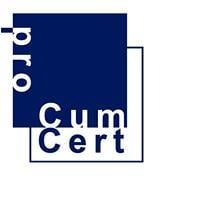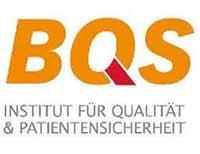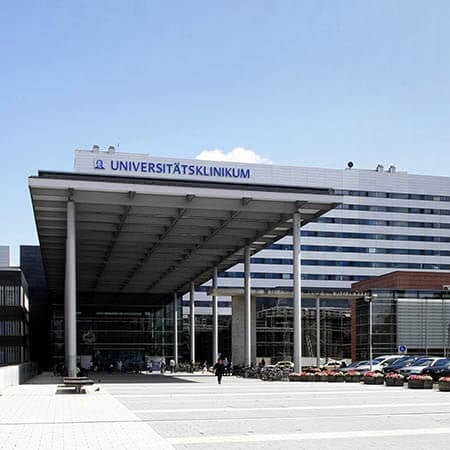An aneurysm is a localized dilation of the blood vessel wall. This disease causes the formation of a "sac" in which blood clots can accumulate. Even if the aneurysm causes no symptoms, it still needs to be treated to avoid life-threatening complications. Doctors in Germany treat the disease not only with surgery, but also with minimally invasive endovascular techniques.
Depending on the type of the aneurysm, the disease is treated with an open surgical or endovascular technique.
You can undergo your treatment in one of the following hospitals: University Hospital of Ludwig Maximilian University of Munich, Charite University Hospital Berlin, or University Hospital Frankfurt am Main.
You do not have to organize your trip yourself because the Booking Health company will take care of this. The company's specialists will select a clinic and a doctor, make an appointment without a long wait, help you to get a visa, arrange flights and the accommodation for your recovery period after surgery, provide interpreting services, and help with any questions that may arise.
Why is an aneurysm dangerous?
An extracranial carotid artery aneurysm is rare: it accounts for less than 1% of all peripheral arterial aneurysms. This disease refers to an increased diameter of the blood vessel by more than 150% of the size of a normal artery.
Atherosclerosis is believed to be the main cause of aneurysm development. Aneurysms are less commonly caused by injuries and infections, as well as rarely occurring as complications after a carotid endarterectomy. Some congenital disorders, such as fibromuscular dysplasia, increase the chance of developing aneurysms.
As a rule, the disease proceeds without any symptoms. However, 50% of untreated patients experience complications, the main one being a stroke. At the site of the aneurysm, blood clots are formed, which then enter the blood vessels of the brain and clog them. The part of the brain deprived of blood supply dies if the patient does not receive emergency medical care (blood clot dissolution or removal) within a few hours. Other less common complications include adjacent cranial nerve compression (the main cause of symptoms) and bleeding due to ruptured blood vessels.
The main goal of treatment for this disease is the prevention of a stroke. At the time of surgery, approximately 20% of patients already have blood clots in their aneurysmal sac.
How can an aneurysm be treated in Germany?
The treatment of extracranial carotid artery aneurysm in Germany can be carried out with the use of the following three methods:
- conservative therapy;
- endovascular treatment (a transluminal angioplasty);
- surgical treatment (an open "repair").
Conservative therapy
Conservative therapy involves the use of anticoagulants and antiplatelet drugs. These medications do not lead to the disappearance of the aneurysm, but reduce the risk of blood clots, which prevents a stroke. Anticoagulants can dissolve the blood clots that have already accumulated in the aneurysmal sac. Nonetheless, conservative therapy does not solve the actual problem. This type of treatment only reduces the risk of thrombosis, but does not completely eliminate it. In addition, medications have to be taken constantly, but if patients stop taking them, blood clots will develop again.
Some aneurysms can be caused by fungal infections. Such patients receive antimycotic therapy. This is not the only treatment, but it complements the surgical intervention to eliminate the aneurysm.
Surgical treatment
An open surgical intervention is considered the "gold standard" for treating extracranial carotid artery aneurysms. The doctors remove the damaged part of the blood vessel and reconstruct the artery. It is possible to form a shunt: a new blood flow path, which is created from an artificial prosthesis or the patient's own vein.
Despite the options available of minimally invasive endovascular procedures for the treatment of extracranial carotid artery aneurysms, open surgery remains the most common option. It is the first-choice technique for true aneurysms (formed due to atherosclerosis), especially in the presence of blood clots. If there are several blood clots present, then during an endovascular procedure, one of them could enter the blood vessels of the brain, clog the artery, and cause a stroke.
Another advantage of surgical treatment of an aneurysm, is the rapid resolution of symptoms. They can be associated with an increase in the size of the aneurysm or a compression of the surrounding tissues and cranial nerves. After the completion of an endovascular treatment, the symptoms are also relieved, due to the gradual remodeling of the aneurysmal sac, but this happens slowly.
Endovascular treatment
An endovascular procedure is performed through an incision on the leg, from inside the blood vessels. The doctors use a contrast agent and X-ray guidance to visualize their actions. They insert a stent into the extracranial carotid artery, which delimits the aneurysm, thereby creating a "bridge" between two healthy sections of the carotid artery. In recent years, there has been a trend towards the increase of the number of endovascular interventions compared to open surgery. However, so far, minimally invasive procedures have not completely replaced conventional surgery. They account for only a third of surgical interventions for extracranial carotid artery aneurysms. The patients with the following conditions are considered the most suitable candidates for endovascular treatment:
- a pseudoaneurysm of traumatic origin;
- a spontaneous carotid artery dissection;
- an aneurysm after a carotid endarterectomy.
However, indications for endovascular treatment are gradually expanding. Increasingly, the procedure is performed for true aneurysms. The use of carotid shunts and brain protection devices during the endovascular procedure can prevent blood clots from entering the cerebral arteries.
Hybrid interventions
Approximately 5% of patients in Germany have extracranial carotid artery aneurysms which are treated with the hybrid technique. The doctors combine open surgery and endovascular interventions. As a result, this operation is closer to the endovascular method than the open one. It combines the isolation of the proximal common carotid artery with endovascular stenting. In these cases, the aneurysm resection is not performed and the artery is not opened. The main therapeutic effect is achieved precisely, through stenting.
Where to undergo treatment?
You can undergo your treatment of extracranial carotid artery aneurysm in Germany. There are a few reasons for you to go to this country:
- high-precision diagnostics, which allows doctors to determine the cause of the development and the type of aneurysm, as well as to choose the best treatment option;
- the ability to cure the aneurysm with the use of a minimally invasive endovascular procedure instead of open surgery;
- the use of brain protection systems to prevent a stroke;
- a low risk of cranial nerve damage;
- in most patients, the aneurysm is cured once and for all; future operations and endovascular procedures will not be required;
- a full rehabilitation after surgery, quality care, and symptomatic treatment.
On the Booking Health website you can see the cost of treatment in different Vascular Surgery Centers, compare prices, and make an appointment for your treatment. We will help you to choose the most suitable hospitals and organize your trip to one of the clinics in Germany.
Authors:
The article was edited by medical experts, board certified doctors Dr. Nadezhda Ivanisova and Dr. Sergey Pashchenko. For the treatment of the conditions referred to in the article, you must consult a doctor; the information in the article is not intended for self-medication!
Sources:
Centers for Disease Control and Prevention
MedicineNet
Sience Direct


















